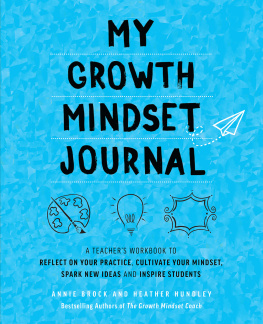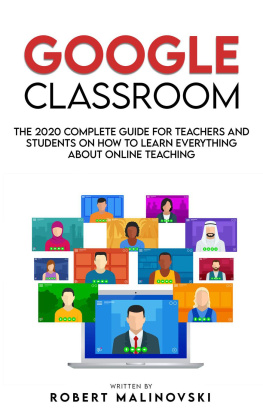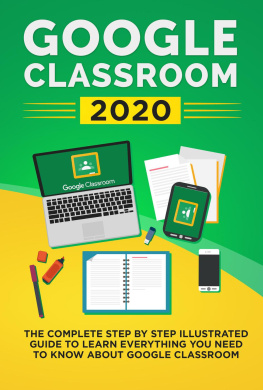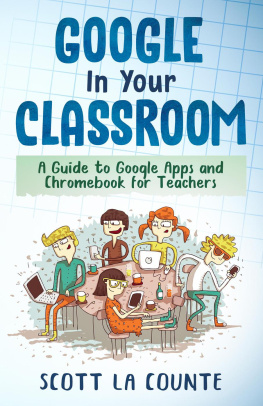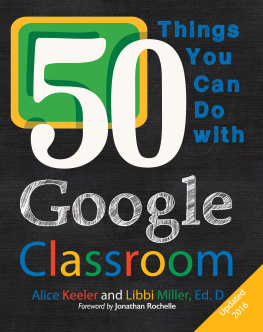Annie Brock - Introduction to Google Classroom
Here you can read online Annie Brock - Introduction to Google Classroom full text of the book (entire story) in english for free. Download pdf and epub, get meaning, cover and reviews about this ebook. year: 2020, publisher: Ulysses Press, genre: Home and family. Description of the work, (preface) as well as reviews are available. Best literature library LitArk.com created for fans of good reading and offers a wide selection of genres:
Romance novel
Science fiction
Adventure
Detective
Science
History
Home and family
Prose
Art
Politics
Computer
Non-fiction
Religion
Business
Children
Humor
Choose a favorite category and find really read worthwhile books. Enjoy immersion in the world of imagination, feel the emotions of the characters or learn something new for yourself, make an fascinating discovery.

- Book:Introduction to Google Classroom
- Author:
- Publisher:Ulysses Press
- Genre:
- Year:2020
- Rating:4 / 5
- Favourites:Add to favourites
- Your mark:
- 80
- 1
- 2
- 3
- 4
- 5
Introduction to Google Classroom: summary, description and annotation
We offer to read an annotation, description, summary or preface (depends on what the author of the book "Introduction to Google Classroom" wrote himself). If you haven't found the necessary information about the book — write in the comments, we will try to find it.
Introduction to Google Classroom — read online for free the complete book (whole text) full work
Below is the text of the book, divided by pages. System saving the place of the last page read, allows you to conveniently read the book "Introduction to Google Classroom" online for free, without having to search again every time where you left off. Put a bookmark, and you can go to the page where you finished reading at any time.
Font size:
Interval:
Bookmark:


Text copyright 2020 Annie Brock. Design and concept copyright 2020 Ulysses Press and its licensors. All rights reserved. Any unauthorized duplication in whole or in part or dissemination of this edition by any means (including but not limited to photocopying, electronic devices, digital versions, and the internet) will be prosecuted to the fullest extent of the law.
Published in the United States by:
Ulysses Press
P.O. Box 3440
Berkeley, CA 94703
www.ulyssespress.com
ISBN: 978-1-64604-165-7
ISBN: 978-1-64604-142-8 (eBook)
Acquisitions editor: Ashten Evans
Managing editor: Claire Chun
Editor: Scott Calamar
Proofreader: Renee Rutledge
Front cover and interior design/layout: what!design @ whatweb.com
Cover illustrations: Freud/shutterstock.com
This book is independently authored and published. No sponsorship or endorsement of this book by and no affiliation with Google LLC, owner of the GOOGLE family of marks, or any other trademarked brands or products mentioned or pictured, is claimed or suggested. All trademarks that appear in this book belong to their respective owners and are used here for informational purposes only. The author and publisher encourage readers to patronize the quality brands and other products mentioned and pictured in this book.
As a twenty-first century teacher, you are facing a set of opportunities and challenges that no other teachers in the history of education have encountered. In the last ten years, an explosion of technology has radically changed the educational landscape. This technology has brought with it incredible benefits like more efficient communication, better access to knowledge and resources, and increased student engagement. But because of its relative newness, its likely your pre-service teaching program did not adequately prepare you to effectively use technology as part of your teaching repertoire.
Todays teachers are poised to change both teaching and learning through integration of technology in the classroom. The business sector thrives on technologyin fact, many of the worlds largest companies, like Apple, Microsoft, and Google, produce it. The world has seen massive globalization thanks to the newfound ability to communicate instantaneously across the planet. Just as technology has transformed the way you live, it has the capacity to transform the way you teach. As the paradigm shifts in other industries, emerging technologies are also offering powerful alternatives to traditional methods of education. Despite these advancements, however, many of todays classrooms look virtually identical to the classrooms of fifty years ago.
Utilizing technology in new and interesting ways in the classroom isnt just important to keeping your teaching style fresh and relevant, its essential experience for your students who will one day venture out to work and live in this technologically driven world.
Blended learning is the practice of combining face-to-face instruction with online learning experiences. Many school districts are encouraging teachers to incorporate blended learning techniques into the traditional classroom model, in an effort to provide students with a more diverse educational experience. No longer are your students limited to learning only what you know or what the textbook says; rather, they have a limitless amount of information at their fingertips. Thus, the goal of teaching should not only be to impart knowledge, but also to assist students in effectively seeking it out for themselves. In the blended learning model, the teacher acts as a facilitator who guides students to ensure that they access new information in a safe, responsible, and purposeful manner.
As we consider ways to meaningfully incorporate technology in our classrooms, there is no better place to begin than Googles G Suite for Education. You undoubtedly already have a handle on what it means to google. After all, the companys powerful search engine is the most popular in the world. However, Google has also developed a sophisticated suite of productivity tools and made them available, free of charge, to schools around the globe.
From Gmail (Googles popular email service) to a host of other products like Google Docs (a word processing program), Google Calendar (an electronic scheduling and calendar solution), and Google Drive (a cloud storage service), Googles suite of communication-driven tools allows teachers and students alike to work smarter. Collaboration is king when it comes to Google for Education (GFE). No longer do meaningful learning experiences have to be bound by the four walls of your classroom. Using G Suite for Education, students can work collaboratively with you and each other and access information any time from any device.
For K12 educators, the built-in creativity, productivity, and communication tools, increased efficiency, and cost-saving capabilities offered by Google provide an incredible opportunity to meet digital natives where they are and prepare them for life in the modern world. No single tool in the suite is better suited to meeting educational needs than Google Classroom.
At its most basic level, Google Classroom is an app that helps teachers easily and efficiently assign, collect, and return work to students. Of course, you could simply replace these once-analog processes with their digital counterparts, but truly harnessing the power of Google Classroom creates an opportunity to do much more. Classroom can serve as the foundation of your blended learning integration strategy. Google refers to Classroom as mission control for your classes; used purposefully, it can be the touchstone for all of the online learning your students will do throughout the year.
You likely already have a system in place to accomplish the tasks of assigning and returning work to students, so why replace that system with Google Classroom? Sure, it can streamline your workflow process, but utilizing Classroom can also enhance your ability to communicate with students, differentiate instruction, and share new concepts and tools in real time. Embedded in the fabric of Google Classroom are new ideas and approaches to education. The focus on a partnership between students and teachers, the tools to access and disseminate valuable information in real time, and the ability to evaluate student progress and give instantaneous feedback make Classroom a game changer.
Aside from these larger implications, Classroom can also impact simple tasks and minor issues by helping to prevent them from becoming major headaches.
Imagine receiving this email:
To: Ms. Brock
From: Frustrated Parent
Re: Sams Essay
Dear Ms. Brock,
Sam told me he turned in his essay on time and you docked him 10 percent for it being late. Can you explain this?
Thanks,
Frustrated Parent
Youve probably received an email or phone message resembling this onean annoyed parent pointing out a discrepancy with the grade youve given and the one they believe their child has earned. This can be a source of irritation for both teachers and parents. But now imagine being able to simply respond with this:
Dear Frustrated Parent,
Attached you will find a time-stamped screenshot showing when Sam uploaded his assignment; it was submitted at 9:17 p.m. on Thursday nightunfortunately, it was due the prior Monday morning. I understand Sam has a lot going on, but if hes unsure about due dates in the future, our class syllabus and calendar can be accessed 24/7 via our Google Classroom. Please let me know if you have further questions!
Font size:
Interval:
Bookmark:
Similar books «Introduction to Google Classroom»
Look at similar books to Introduction to Google Classroom. We have selected literature similar in name and meaning in the hope of providing readers with more options to find new, interesting, not yet read works.
Discussion, reviews of the book Introduction to Google Classroom and just readers' own opinions. Leave your comments, write what you think about the work, its meaning or the main characters. Specify what exactly you liked and what you didn't like, and why you think so.

